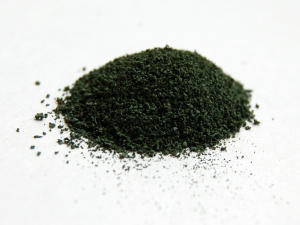







Search:

Chromium(III) oxide
|
1. $(NH_4)_2S$ |
|
$S^{2-}$ $+$ $H_2O$ $\longrightarrow$ $HS^-$ $+$ $OH^-$, then $Cr^{3+}$ $+$ $3OH^-$ $\longrightarrow$ $Cr(OH)_3$ - Green precipitate |
|
2. $KOH$ |
|
$Cr^{3+}$ $+$ $3OH^-$ $\longrightarrow$ $Cr(OH)_3$ - Green precipitate - Soluble in $HCl$ - Soluble in an excess of reagent: $Cr(OH)_3$ $+$ $OH^-$ $\longrightarrow$ $[Cr(OH)_4]^-$ - Emerald green complex, - Soluble, - Tetrahydroxochromate(III) - By boiling we observe decomplexing and reprecipitation of $Cr(OH)_3$ |
|
3. $NH_3$ |
|
$Cr^{3+}$ $+$ $3OH^-$ $\longrightarrow$ $Cr(OH)_3$ - Green precipitate - Soluble in $HCl$ - Slow complexing in excess reagent: $Cr(OH)_3$ $+$ $6NH_3$ $\longrightarrow$ $3OH^-$ $+$ $[Cr(NH_3)_6]^{3+}$ - Purple complex, - Soluble - Hexamminechromium(III) - By action of hot $NH_3/NH_4Cl$ , we observe decomplexing and reprecipitation of $Cr(OH)_3$ |
|
4. $Na_2O_2$ |
|
$Na_2O_2$ may be considered as $H_2O_2$ in a concentrated basic medium: $2Cr^{3+}$ $+$ $8OH^-$ $\longrightarrow$ $2[Cr(OH)_4]^-$ $2[Cr(OH)_4]^-$ $+$ $3H_2O_2$ $+$ $2OH^-$ $\longrightarrow$ $2CrO_4^-$ $+$ $8H_2O$ - Chromate - Yellow, - Soluble |
|
5. $Br_2/NaOH$ |
|
$2Cr^{3+}+8OH^-\longrightarrow 2[Cr(OH)_4]^-$ $2[Cr(OH)_4]^-$ $+$ $3Br_2$ $+$ $8OH^-$ $\longrightarrow$ $2CrO_4^-$ $+$ $6Br^-$ $+$ $8H_2O$ - Chromate - Yellow, - Soluble |